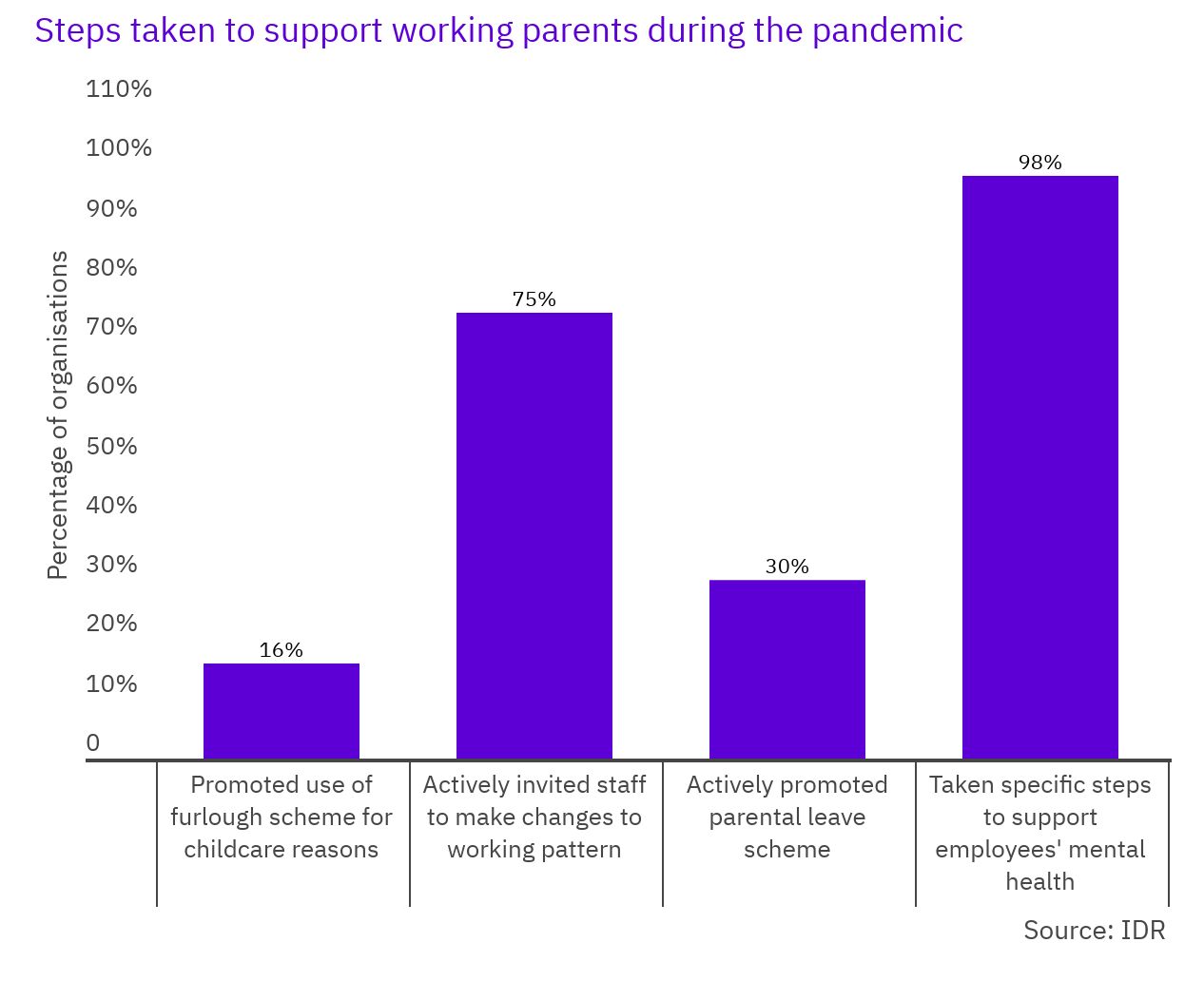The most common measure employers have taken to support working parents during the latest period of home learning is to take active steps to promote mental wellbeing, a new study of 40 organisations by IDR has found, while three-quarters of organisations have invited staff to make changes to their working patterns. However, the research finds that more could be done to promote existing measures to staff who are juggling their work and home-learning commitments.
Supporting employees’ mental wellbeing
Almost all respondents (98%) report that they have taken specific steps to support employees’ mental wellbeing during the pandemic. ‘While much of this is geared around reminding staff how they can access existing provision, such as employee assistance programmes, trained mental health first-aiders or online information, new measures have often focused on creating opportunities to foster and maintain social connections between colleagues, such as virtual coffee mornings or online chat channels,’ explains Katherine Heffernan, Principal Researcher at IDR. Some organisations are also actively seeking to monitor employees’ mental wellbeing by making this the focus of staff surveys and undertaking stress risk assessments. Most activities in this area have been in place throughout the pandemic as large proportions of the workforce have been based at home for extended periods of time. However, some measures we observed, such as guidelines around meeting scheduling and conduct, appear to have working parents’ specific needs in mind.
Changes to working patterns
Three-quarters of employers have actively invited staff to make temporary changes to their working patterns to accommodate home-learning responsibilities. In practice – and bearing in mind that such changes are not always recorded centrally, possibly masking the full picture here – this most commonly takes the form of informal flexitime arrangements (58% of organisations), while 43% have seen staff make temporary changes to shift patterns and 28% have allowed some staff to reduce their working hours temporarily to help balance work and school responsibilities. Where staff have temporarily reduced their working hours, several respondents are continuing to pay them at their full rate. Few organisations have put any rules or guidelines in place regarding ‘core’ hours that must be worked, instead allowing employees the flexibility to arrange work and home-learning commitments as best meets their needs.
Statutory provisions
Our survey findings show that only 30% of organisations have actively reminded staff of their statutory entitlement to request unpaid parental leave while fewer still (16%) have highlighted to employees that they can apply to take furlough under the Coronavirus Job Retention Scheme for childcare reasons. ‘Employers could be missing a trick here given that such schemes need not entail any additional costs for them,’ says Heffernan. Two respondents have temporarily improved their parental leave policies in response to coronavirus, such that some or all such leave is now paid, while a handful of others include parents in their broader carers’ or dependants’ leave policies.
Managing workloads and performance management
Where working parents have reduced their working hours or taken furlough, what happens to the work they would have done? The most common approach to handling the remaining workload (75% of organisations) is to reschedule some of those individuals’ priorities or deadlines to later in the year. In around three-fifths (63%) of cases, some work has been redistributed to colleagues who have absorbed this into their existing workload, although a further 29% have paid remaining staff to work additional hours. Only a quarter of these employers report that they had intended to furlough some staff anyway, while 8% have had to appoint new staff to handle the outstanding tasks.
Mindful of the potential disruption to employees’ productivity levels, a quarter of respondents have amended their performance-management practices in some way due to the pandemic – for example, by delaying appraisals or taking a more ‘light-touch’ approach for the time being. Meanwhile, specific measures have been put in place at just over half (51%) of the sample to help line managers support team members affected by coronavirus.







